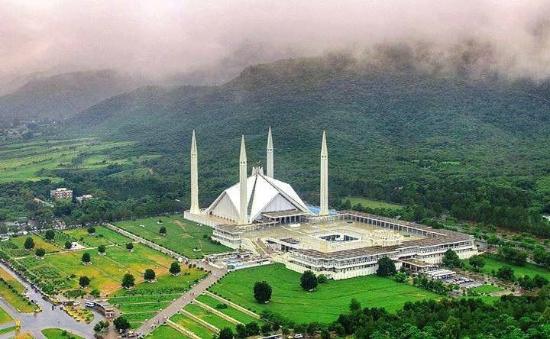The Faisal Mosque in Islamabad is the 6th largest mosques in the world. The mosque is popular in the Islamic world and famous for its size and architecture. By design, Faisal mosque is a blend of ultramodern and conventional architecture. The Faisal Mosque is sited at the foothills of the Margalla Hills at an elevated land and can be seen day and night from miles. Unusual in design, the mosque is one of the key tourist attractions in Islamabad and permissible to people of all faiths. Faisal mosque is considered a national mosque of Pakistan.
History of Faisal Mosque
When Shah Faisal of Saudi Arabia visited Pakistan in 1966, he supported the initiative to build a grand mosque, giant as largest in the world that time, in Islamabad. Four years later, in this regard, in 1969, an international competition held and 43 architects from 17 countries submitted design proposals. The unique design submitted by the Turkish architect Vedat Delokay was approved as the final design. Vedat Delokay was the recipient of the Aga Khan Award for Architecture for this project.
Construction of the mosque began in 1976 and it took 10 years to complete the whole building. Finally, in 1988, the project was completed at a total cost of 130 million Saudi Riyal (US$ 120 million) fully financed by King Shah Faisal. It has the honor of being the largest mosque of the world from 1988 to 1993 until the Hasan II mosque of Casablanca in Morocco was built. The name given to the mosque, as Shah Faisal Mosque, was named after the late King Faisal Bin Abdul Aziz of Saudi Arabia.
Art & Architecture
The unconventional design without domes and arches was inspired by a desert Beduin tent. The main hall is surrounded by four equal height minarets adjoining its four corners as tall as 260 feet (79 m) and 10 x 10 m in circumference. The eight-sided shell shaped sloping roofs forming a triangular worship hall feature a contemporary design and reflect a stark contrast from the conventional Islamic architecture. At the time of construction the design was heavily criticized for its unconventional design but with its completion, the criticism also pacified.
The interior of the main building is richly decorated with mosaics and calligraphy by Sadequain, the famous Pakistani artist. The overhanging spectacular Turkish-style chandelier from the 40-meter high roof is an added beauty. West wall of the building is adorned with mosaic pattern and has Kalimah written on in early Kufi script.
Accommodation Capacity
The hall can accommodate 10,000 worshippers at a time. The front of the hall is a huge courtyard and can accommodate up to 40,000 worshippers. The whole structure of the mosque covers an area of 5,000m2 (54,000 sq. ft.). The surrounding porticoes, courtyard, and adjoining grounds have the capacity to hold more than 200,000 worshippers at a time.
Location and Attractions
The Faisal Mosque is situated at the foot of Margalla Hills, at the north end of Faisal Avenue – the name given to the road leading to the mosque after the assassination of King Faisal in 1975. The ground floor of the mosque housed the campus of International Islamic university now moved to a different location.
The mosque is surrounded by lush green grounds. The mausoleum of the late President, Zia ul-Haq who died in an air crash in 1988, is adjacent to the mosque. the surroundings are all decked with green carpeted grass, trees, flowers of various kinds, sitting areas and ample parking lot. The best view of the mosque is probably from Daman-e-Koh viewpoint.
The building can be entered from a small courtyard surrounding a small water pond. The staircases on both sides of the courtyard lead up to the main courtyard of the mosque. The main courtyard offers the best view of the main building and surroundings.
Instructions
Visitors are always welcome and are free to explore all areas of the building and take photographs. The courtyard of the building presents a scenic view of the surrounding Margalla hills. This place is quite peaceful and cool during summers.
While entering the main building, visitors must leave shoes at the counter. Remember to dress conservatively, women especially must wear a headscarf. Avoid eating, dancing, singing or making loud voices.




Comment (0)